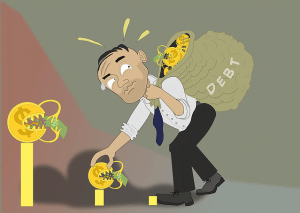
Two ratios can help you keep track of your financial progress. Your spending ratio is money that works for you today, while your savings ratio is money that will continue to work for you in the future. Your goal is to reduce your spending ratio over time, in order to improve your savings ratio. We discuss this in more detail in a later post in this series.
You can improve your savings ratio in a number of ways. The first is by putting more of your money towards paying off your debts. You can also improve your savings ratio by contributing more to both your short-term and long-term savings. Short-term savings are for big expenses in the next five years, while long-term savings are designed to help you achieve financial independence.
In later posts, we’ll discuss how to set financial goals and the common obstacles that prevent us from reaching them. Today we’ll discuss a fool-proof debt repayment strategy and some of the common pitfalls that prevent us from successfully settling our debts.
Goal one: Paying off your debts
As we explain here, we have to pay a fee for the privilege of using other people’s money. This fee is called interest and it’s the reason debt is bad for us. Setting a goal to pay back debt is as important as having savings goals. Sometimes having debt costs us more than our savings can earn us.
How to set a debt repayment goal
Once we understand the true cost of debt, it’s tempting to try and get rid of our debts as soon as possible. We might end up over-committing to our debt repayments, which forces us to take on more debt. This cycle can be so demoralising that we end up giving up altogether.
Repaying debt is like eating an elephant – you have to do it one bite at a time. You can implement the below steps one month at a time over a few months, or all at once. Take it at a pace that feels comfortable for you.
- Identify the smallest amount of money you owe and make a commitment not to take on any additional debt in that account. For example, if you have a clothing account where you owe a small amount of money, just commit to not buying anything new using that account. Continue making the required payments to that and all other accounts. You can continue using all your other accounts like you normally would.
- Find a small amount of money in your day-to-day spending to contribute above the minimum payments to your account. For example, if you know you’re spending R50 per month on fizzy drinks that are bad for your health, add your fizzy drink money to the minimum payments of the account you identified in step one. Remember not to take on any more debt in that account.
- Repeat steps one and two until you no longer owe anything on the account you chose. When the account has been settled, close it. This is an important part of the process. We tend to view available debt as our money. It’s not.
- Take the money you would have contributed to your first account and contribute it to the next account in line.
You can repeat this process until you’ve gotten rid of all of your accounts. The great thing about this strategy is you’ll end up with a huge amount of cash in your pocket once you’ve paid off your last account. This is the cash that will go towards your first savings goal.
Why you’re not getting it right
It’s no coincidence that debt repayments are counted towards your savings ratio, not your spending ratio. The type of behaviour required to repay debt is very similar to the type of behaviour required to save successfully.
The biggest mistake we make is over-committing. Just like making a decision to exercise doesn’t immediately make you fit, making a decision to be better with money won’t immediately solve your financial problems. It’s a slow process, which can be frustrating.
Trying and failing at this strategy is a sign that your steps are too big. Even something as simple as not taking on more debt is taking positive action. It’s hard to believe because we don’t immediately have anything to show for our efforts. Trust that it will come in time. You don’t have to succeed on your first try either. If you tried this month and didn’t quite crack it, try again next month. You’ll get there!
If you need more immediate advice on dealing with debt, go to this short blog series.
OUTstanding Money

This series of articles was sponsored by OUTvest, and written by Just One Lap in 2018. It’s timeless wisdom that needs to be out there – in public spaces where it can feed into ongoing discussions about long term financial wellness.
